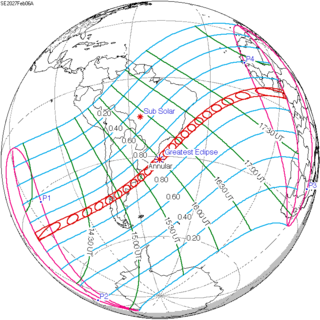| Solar eclipse of February 6, 2027 | |
|---|---|
| Type of eclipse | |
| Nature | Annular |
| Gamma | −0.2952 |
| Magnitude | 0.9281 |
| Maximum eclipse | |
| Duration | 471 s (7 min 51 s) |
| Coordinates | 31°18′S 48°30′W / 31.3°S 48.5°W |
| Max. width of band | 282 km (175 mi) |
| Times (UTC) | |
| Greatest eclipse | 16:00:48 |
| References | |
| Saros | 131 (51 of 70) |
| Catalog # (SE5000) | 9567 |
An annular solar eclipse will occur at the Moon's ascending node of orbit on Saturday, February 6, 2027,[1] with a magnitude of 0.9281. A solar eclipse occurs when the Moon passes between Earth and the Sun, thereby totally or partly obscuring the image of the Sun for a viewer on Earth. An annular solar eclipse occurs when the Moon's apparent diameter is smaller than the Sun's, blocking most of the Sun's light and causing the Sun to look like an annulus (ring). An annular eclipse appears as a partial eclipse over a region of the Earth thousands of kilometres wide. Occurring about 3.2 days after apogee (on February 3, 2027, at 13:30 UTC), the Moon's apparent diameter will be smaller.[2]
The path of annularity will first pass through Chile (including the city of Castro) and Argentina (including the city of Viedma), then scraping the east coast of Uruguay (including the city of Punta del Este) and Brazil. The eclipse will then pass across the South Atlantic Ocean, terminating on the West African coast, where it will pass over the southeastern Ivory Coast (including the city of Abidjan), southern Ghana (including the capital Accra), southern Togo (including the capital Lomé), southern Benin (including Cotonou and the capital Porto Novo), and southwestern Nigeria (including Lagos). A partial eclipse will be visible in much of South America, parts of Antarctica, and much of the western half of Africa.
- ^ "February 6, 2027 Annular Solar Eclipse". timeanddate. Retrieved 13 August 2024.
- ^ "Moon Distances for London, United Kingdom, England". timeanddate. Retrieved 13 August 2024.
